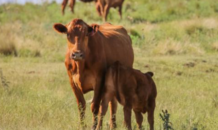Irrigation provided from underground water sources steps in to save the day for many agricultural producers in the Great Plains. However, they are discovering underground water sources are equally affected by drought as the nation’s largest underground source of freshwater in the country, the Ogallala Aquifer, is drying up at an alarming rate.
“There is a tremendous amount of agricultural production coming out of this aquifer,” said Jason Warren, associate professor in Oklahoma State University’s Department of Plant and Soil Sciences.
In attempt to save the Ogallala Aquifer, OSU is teaming up with seven other universities, as well as the USDA-Agricultural Research Service for innovative research and Extension activities aimed at addressing the challenges. Led by Colorado State University, the consortium recently received a $10 million USDA Water for Agriculture Challenge Area CAP grant.
Spanning nearly 174,000 square miles, the Ogallala Aquifer is the primary water source for the region, including nearly all of Nebraska and sections of Colorado, Kansas, New Mexico, Oklahoma, South Dakota, Texas and Wyoming. According to the U.S. Geological Survey, the aquifer’s overall water level dropped by 36 million acre-feet.
“Oklahoma represents a small portion of what the aquifer serves,” Warren said. “However, the Ogallala does provide the productivity of 25 percent of our agricultural receipts, serving Beaver, Texas and Cimarron counties.”
Most of the acreage in those three major agricultural-producing counties is irrigated. Part of this research is to find out how long this area can continue to be irrigated, rather than being converted to dry land.
“There are questions in the proposal as to what would the agricultural landscape look like if there were no more irrigation,” said Warren. “We have very limited data. We don’t know enough to know what is happening. That’s what this is, to try and assimilate some of that information and the expertise to gain a better understanding.”
The group will be evaluating many different items throughout the project. They will monitor the changes in soil characteristics as irrigated land is converted to dry land production systems as well as the need for a transition of cropping systems in the high plains as a function of changing weather conditions and climate.
Warren’s part of the project will research limited irrigation.
“As we reduce our availability to water, how do we most economically utilize the water,” he said. “Instead of just pumping it out of the ground as fast as we can when it’s limited, do we need to change crop selection?”
The collaboration will shed some light at a regional scale on how to manage the water resource into the future to maximize its economical value and keep producers afloat.




